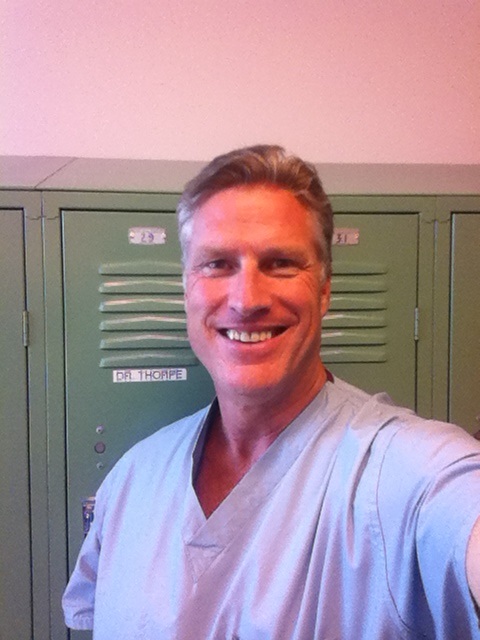Michael Thorpe, MD, an orthopedic surgeon at Pacific Rim Outpatient Surgery Center in Bellingham, Wash., was one of outpatient total joint's early pioneers. Alongside fellow surgeons and anesthesiologists, he opened Pacific Rim Outpatient Surgery Center in 2003. The independent, for-profit ASC is currently comprised of nearly 45 shareholders.
 In 2005, Dr. Thorpe opted to move his cases out of the hospital after unsuccessful negotiations with his hospital concerning ER call coverage in orthopedics and launched the center's total joint replacement program. He teamed up with the ASC's medical director, a tripled board-certified anesthesiologist, to develop best practices and protocols after reviewing national protocols.
In 2005, Dr. Thorpe opted to move his cases out of the hospital after unsuccessful negotiations with his hospital concerning ER call coverage in orthopedics and launched the center's total joint replacement program. He teamed up with the ASC's medical director, a tripled board-certified anesthesiologist, to develop best practices and protocols after reviewing national protocols.
Here are five concepts that make Pacific Rim's total joint replacement program possible:
1. Payers are jumping on board. When Pacific Rim's total joints program launched in 2005, only one payer, Kaiser Permanente partner Group Health Cooperative was willing to work with the surgery center. The payer reviewed the ASC's protocols and saw the potential cost savings ASCs could accrue. In January 2014, Blue Cross Blue Shield began working with the ASC on its total joint replacement program. The number of payers continues to increase, especially as more centers utilize bundled payments.
"When bundled payments come, a payer would look at us and see that they can spend $30,000 for a total knee when it costs $60,000 or more at a hospital," says Dr. Thorpe. "Surgeons can actually start bargaining to get their fee higher. Orthopedics is lucrative right now for ASCs because you are doing bigger cases now that are reimbursed well."
2. Updated pain management protocols. Since the program took off, the ASC stopped using drains, femoral nerve blocks for knee replacements and staples on the skin, as well as decreased narcotic use. Dr. Thorpe uses an Exparel/Marcaine mixture for pain control during the postoperative period. Patients undergoing a total joint procedure participate in physical therapy beginning the night of surgery and the next morning prior to discharge, then at home through a home health agency.
"I stopped using morphine in spinal blocks and now we use oral narcotics," Dr. Thorpe says. "The local hospital implemented a lot of what I had been doing at the surgery center. Our practices have drifted along together."
3. Patients have a strong home support system. Outpatient total joint procedures require healthy patients with a strong support system to reap success.
"We choose ASA class I and II patients, and sometimes we'll do a healthy III," says Dr. Thorpe. "You don't want a patient who isn't going to thrive postop at home. You want them healthy and motivated."
Prior to the procedure, the surgeon ensures a patient's home is sufficiently set up. A physical therapist will go to a patient's home pre-op if needed and postop until the patient can do the exercises themselves or travel to an outpatient facility.
4. Hiring and retaining dedicated staff. The ASC built a support staff around Dr. Thorpe focus on total joint replacements for maximum quality and efficiency. "You need a dedicated OR team to development a solid TJR program," Dr. Thorpe says. "You can't just have a fill-in team."
Equipped with eight stage-one recovery bays, three pediatric recovery bays and five stage-two recovery bays, Pacific Rim Outpatient Surgery Center's patients recovering from a total joint procedure stay for just under 24 hours following the procedure. The ASC's team members are with the patient from the procedure through the recovery process to ensure the patient is recovering well.
5. Paving the way for other ASCs adding TJR. The program has served as a vital resource for other surgery centers interested in integrating total joint into their repertoire of offerings. Since the program started, several surgery center staff members and surgeons from surrounding cities including Mount Vernon, Renton, Richland and Everett, have visited Dr. Thorpe and staff members to learn about the center's total joint replacement successes. Within the Bellingham region, however, Dr. Thorpe is the sole surgeon doing outpatient total joints in ASCs.
"Outpatient TJR will continue to grow and grow until everyone is brave enough to do it," says Dr. Thorpe. "A lot of surgeons don't want to start, and that is because of strong hospital joint center programs already in place and many orthopedic surgeons are employed by the hospitals. There is an unspoken disincentive there."
More healthcare news:
Panel favors AmSurg in non-compete controversy with physicians: 5 things to know
10 largest ASC chains in the US
3 challenges ASC face in multidisciplinary antibiotic stewardship program implementation

